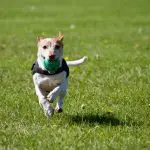Important things to consider before deciding to take on a deaf dog
Owning a dog that has no hearing can be both a rewarding and educating experience. Owning a dog that has good hearing and sight can often lead us into being a little lazy, when it comes to establishing effective patterns of communication between us and our pet. For the most part we struggle through with a few voice commands and maybe the occasional hand signal, that often change depending on the situation. Fortunately, in a lot of situations our dogs learn to navigate their way around our impromptu communication style and, begin to ‘catch on’ to what it is we want from them.
Owning a deaf dog however is a different story; many owners of deaf dogs testify to how much their lives have changed since their deaf dog come to live with them. They often talk in terms of how different and, in many case better their relationship is in terms of both communication and depth.
Dogs experience deafness due to a number of reasons; many dogs are born deaf. This type of deafness is referred to as Congenital Deafness, it’s cause is due to a defective gene. Other causes of deafness in dogs are usually the result of accidents, illness or old age.
If you are thinking of sharing your life with a deaf dog, then understanding, patience and, a willingness to adapt will put you in good stead. Amongst the most important things to consider are keeping your new pet safe, developing an appropriate means of communication, and making your home a comfortable and, secure place for your dog to live.
Dogs that are deaf are prone to being touch sensitive and, can also become startled much easier that dog who have no problems with their hearing, for example, if somebody approaches them from behind and touches them, or if roused from sleep. When owning a deaf dog you will need to keep this in mind and, adapt the ways in which you approach and, handle your dog. This is especially important for those with young children, as children can be boisterous at times and, a child running up and touching a dog that can not see him or her coming could cause the dog to become nervous or even try to bite.
To help your deaf dog adjust, try approaching him head on, stamping your feet as you approach your dog from behind can also be very helpful, as the vibrations will alert him. If you have children teach them to approach your dog calmly and to touch him gently.
If your deaf dog is particularly touch sensitive, try to help him become accepting of your touch by giving him a tasty food treat each time you pet him. With practice, your dog will begin to associate your ‘unexpected’ touch with a feeling of pleasure.
Two more important things to consider when making your home a safe and pleasurable place for your dog are, not to leave doors or gates open, so as your dog can escape and be left unattended, as this could be disastrous. If your new dog is going to be left alone for some time during the day, you may consider it wise to train him to spend time in a dog crate. However, do keep in mind due to your dog not being able to hear he may become restless, or even frightened at being left alone in his crate. Deaf dogs can also be particularly prone to separation anxiety, so do make sure your dog has plenty to occupy himself with during the time he spends alone.
The biggest dangers posed to your deaf dog will be when you are out and about, especially if you live in a town or city, where there is a lot of traffic. Keep your dog on his leash, at least until you are in a place where it is safe to manage him off leash. However, it is important to do this only when your dog is performing a consistent recall.
Working on building a way of communication that both you and your dog are familiar with is vitally important to sharing your life with a deaf dog. As your dog will not be able to hear you, only hand signals will do. In fact dogs are well ahead of us in terms of being able to read body language. You can use hand signals taken from sign language designed for humans, for example, British or American sign language, or use signs from these languages that have been adapted especially for using with dogs, or alternatively you can design your own signs. Using smiles and mouthing your commands will also help to reinforce your new hand signals, however, the key is keep your hand signals consistent and simple, so as not to cause your dog to become confused.
When it comes down to it owning a deaf dog is not dissimilar to owning a dog that can hear. All that is needed is a little extra patience, understanding, love some consistent work on your part and, you will come to develop a relationship with your dog that is difficult to compare.


